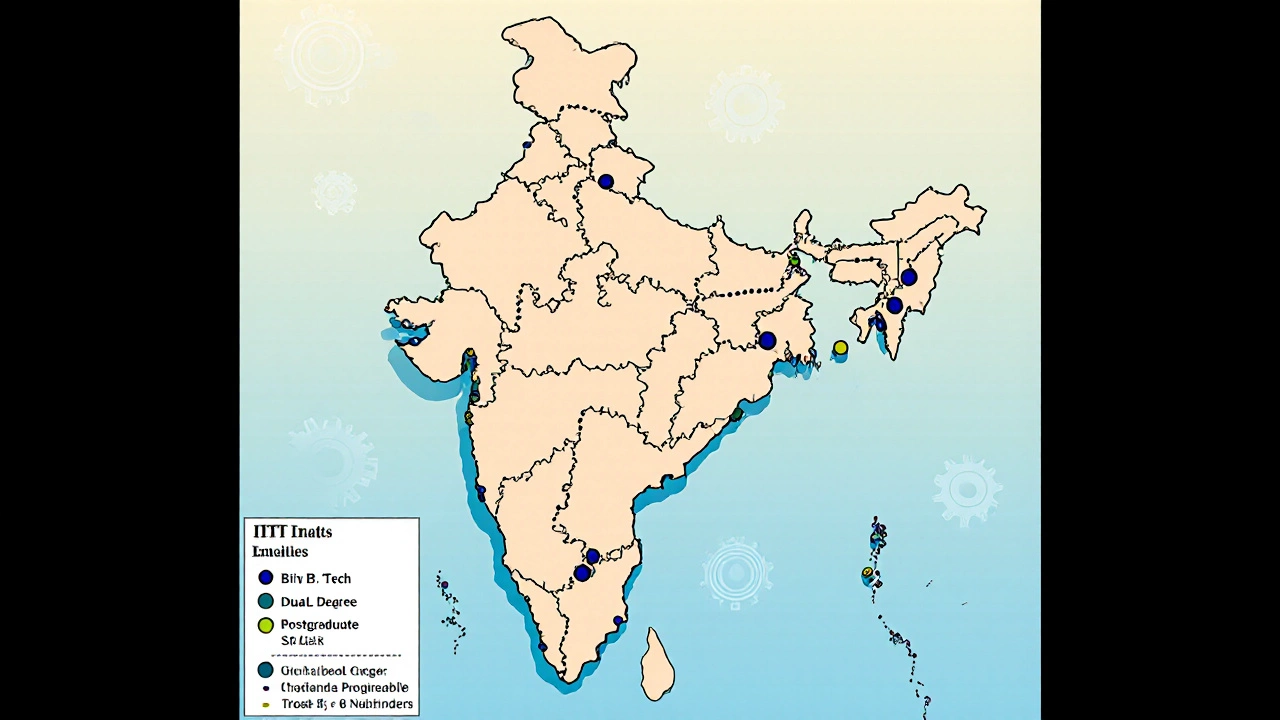IIT Seat Reservation Calculator
Reservation Seat Calculator
Calculate how many seats are allocated to each reservation category based on the official IIT seat matrix policy. Enter the total number of seats to see the breakdown.
Reservation Breakdown
| Category | Percentage | Number of Seats |
|---|---|---|
| General (Unreserved) | 65% | 16120 |
| OBC-NCL | 27% | 6696 |
| SC (Scheduled Castes) | 15% | 3720 |
| ST (Scheduled Tribes) | 7.5% | 1860 |
| PwD (Persons with Disability) | 5% | 1240 |
Ever wondered exactly how many IIT seats are up for grabs across India? If you’re prepping for JEE Advanced, that number isn’t just a curiosity - it shapes your strategy, informs your rank targets, and helps you gauge competition.
Indian Institutes of Technology are a group of premier engineering colleges that together award thousands of undergraduate and postgraduate places each year. Since their inception in 1951, the IIT system has expanded from a single campus in Kharagpur to 23 institutes spread over the country.
Why Seat Numbers Matter for JEE Aspirants
Knowing the total seat pool does three things:
- It gives a realistic picture of how many candidates can actually secure a seat at a given rank.
- It highlights which institutes have the biggest capacities, letting you prioritize your preferences.
- It reveals growth trends - a rising seat count often means newer institutes or added programmes, which can affect cut‑off trends.
Overall Seat Count for 2025
For the academic year 2025‑26, the Ministry of Education released the official seat matrix. The total number of undergraduate seats (B.Tech and Dual Degree) across all IITs is 24,800. Adding postgraduate programmes (M.Tech, M.Sc., and Ph.D.) brings the grand total to roughly 29,500 seats.
Breakdown by Programme
Here’s how those numbers split:
- B.Tech: 20,400 seats
- Dual Degree (B.Tech + M.Tech): 4,400 seats
- M.Tech (post‑graduate): 3,500 seats
- M.Sc. (Science programmes): 600 seats
- Ph.D. research positions: 200 seats
The B.Tech count dominates because it’s the core undergraduate offering that JEE‑Advanced candidates compete for.
Seat Distribution Across Individual IITs
Not every campus has the same capacity. The older IITs - often called the “IIT Triad” - hold the bulk of seats, while newer institutes are still scaling up.
| Institute | B.Tech Seats | Dual Degree Seats | Total UG Seats |
|---|---|---|---|
| IIT Bombay | 1,800 | 300 | 2,100 |
| IIT Delhi | 1,700 | 350 | 2,050 |
| IIT Madras | 1,650 | 320 | 1,970 |
| IIT Kanpur | 1,600 | 310 | 1,910 |
| IIT Kharagpur | 1,850 | 340 | 2,190 |
| Other 18 IITs (average) | 12,500 | 2,480 | 14,980 |
Collectively, the five oldest IITs account for about 9,200 undergraduate seats - nearly 38 % of the total UG capacity.

Reservation and Category Quota Breakdown
India’s reservation policy applies to IIT admissions just like other public institutions. The seat matrix incorporates the following quotas for each IIT (values are rounded to the nearest whole seat):
- General (Unreserved): 65 %
- Other Backward Classes (OBC‑NCL): 27 %
- Scheduled Castes (SC): 15 %
- Scheduled Tribes (ST): 7.5 %
- Persons with Disability (PwD): 5 % (horizontal, across all categories)
These percentages are applied after the total seat count is finalized, meaning the absolute number of seats per category fluctuates year‑by‑year as the overall capacity changes.
How JEE Advanced Rank Translates to Seats
Admission isn’t a first‑come‑first‑served lottery; it’s a merit‑based matching process called the Joint Seat Allocation Authority (JoSAA) counselling. Here’s a quick snapshot of typical opening rank ranges for the most sought‑after programmes in 2025:
| Institute | Computer Science (CS) | Electrical Engineering (EE) | Mechanical Engineering (ME) |
|---|---|---|---|
| IIT Bombay | 1‑100 | 1‑300 | 1‑750 |
| IIT Delhi | 200‑350 | 400‑600 | 1‑1000 |
| IIT Madras | 250‑400 | 500‑800 | 1‑1200 |
| IIT Kanpur | 300‑500 | 600‑950 | 1‑1300 |
| IIT Kharagpur | 400‑600 | 800‑1150 | 1‑1500 |
These rank windows shift each year based on the total number of seats, the difficulty of the exam, and how many candidates opt for a particular branch.
Trends Over the Last Decade
From 2015 to 2025, the IIT system added six new institutes (IIT Bhubaneswar, Gandhinagar, Patna, Ropar, Indore, and Palakkad). That expansion contributed to a 22 % increase in total undergraduate seats - from about 20,300 in 2015 to 24,800 today.
Notably, dual‑degree programmes grew fastest, jumping from 1,200 seats in 2015 to 4,400 now. The surge reflects industry demand for graduates who already hold a master’s qualification.

Practical Tips for Aspirants
- Target realistic rank ranges: Use the opening‑rank tables above to set achievable goals based on your practice scores.
- Keep an eye on new IITs: Institutes like IIT Bhubaneswar often have higher opening ranks for popular branches, offering a viable backup.
- Don’t ignore horizontal reservations: PwD seats are allocated after category merit, so early application can secure a spot.
- Track seat matrix updates: The Ministry releases the final numbers in June each year; a last‑minute change can affect cut‑offs.
- Consider branch flexibility: If CS seems out of reach, look at EE or ME where the cut‑offs are comparatively lower but still offer strong career prospects.
Frequently Asked Questions
How many total IIT seats are there for B.Tech in 2025?
The combined B.Tech capacity of all 23 IITs for the 2025‑26 academic year is 20,400 seats.
Do newer IITs have fewer seats than the older ones?
Yes. Institutes that started after 2008 typically offer 500‑800 B.Tech seats each, while the historic IITs (Bombay, Delhi, Madras, Kanpur, Kharagpur) each exceed 1,600 seats.
What is the reservation percentage for OBC‑NCL candidates?
OBC‑NCL candidates are allotted 27 % of the total seats after the unreserved quota is filled.
How are dual‑degree seats counted?
Dual‑degree seats are part of the undergraduate matrix; a student enrolls in a 5‑year B.Tech + M.Tech programme and occupies one seat in the overall UG count.
Where can I find the official seat matrix?
The Ministry of Education publishes the seat matrix on its official website every June. It’s also mirrored on the JoSAA portal during counselling.
Next Steps After Understanding Seat Numbers
Now that you know the exact count and how it’s split, align your study plan with realistic rank targets. Use mock‑test scores to estimate where you’ll land on the opening‑rank tables, then shortlist IITs and branches that match your aspirations. Finally, keep the seat‑matrix PDF handy for the JoSAA counselling window - a last‑minute change in seat count could shift cut‑offs in your favour.
Armed with solid numbers, you can approach JEE preparation with a clearer picture of the battlefield. Good luck, and may your rank land you a seat at the IIT of your dreams!







0 Comments